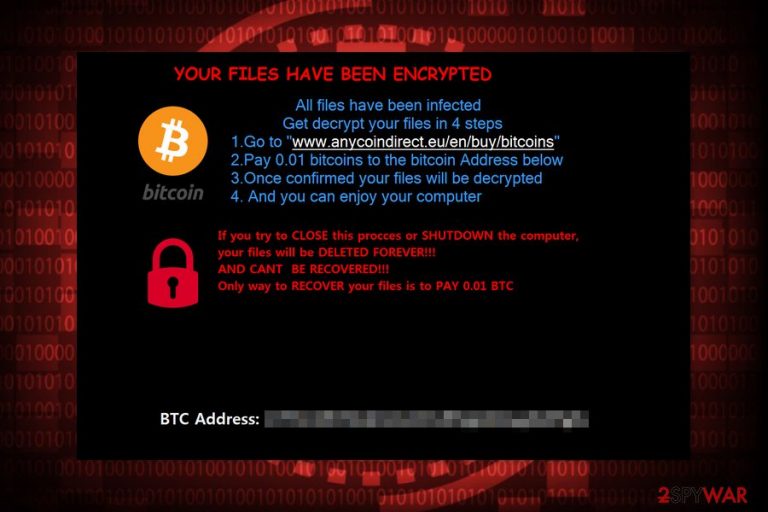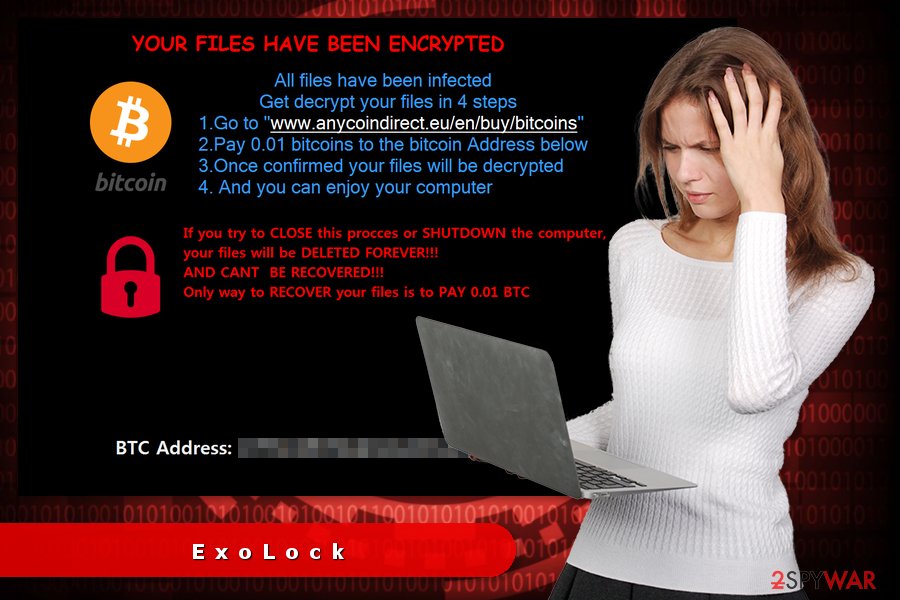ExoLock ransomware / virus (Easy Removal Guide) - Bonus: Decryption Steps
ExoLock virus Removal Guide
What is ExoLock ransomware virus?
After taking files to hostage, ExoLock demands 0.01 Bitcoins

ExoLock is a ransomware virus that has been discovered on the first part of September 2017. The virus appends .exolocked file extension to the encrypted files and demands 0.01 Bitcoins in exchange of data decryptor. No matter how important your files are, you should not follow these instructions.[1]
Following data encryption, ExoLock ransomware opens a ransom-demanding window. The authors of the crypto-malware inform about this unpleasant situation and tell that victims can get back access to their files if they pay. In order to scare people, criminals claim to delete files and make them unrecoverable if a user closes the ransom note or shuts down the computer.
No matter how hard crooks try to convince that paying the ransom is the only data recovery method, you should not let them fool you. Malware[2] researchers are currently investigating the virus and might soon present a free, and most importantly, safe decryption software. Meanwhile, you should remove ExoLock without worrying that this action might lead to deletion of data.
ExoLock virus usually arrives on the system with the help of malicious email attachment. Once a user opens it, malware payload is dropped and executed on the system. Then it not only starts a complicated data encryption process but might make other changes, such as:
- create new or modify old Registry entries;
- inject malicious code into the legitimate system processes;
- install dangerous files, programs, and other entries;
- open the backdoor;
- make programs crash;
- disable computer’s security.
Thus, the file-encrypting malware is a complex cyber infection that negatively impacts computer’s performance, and there’s no way that you will be able to use your PC normally. To reject all the changes to your device, you have to perform automatic ExoLock removal with FortectIntego or SpyHunter 5Combo Cleaner. The detailed explanation is given at the end of the article.

Methods used to spread the ransomware
Developers of crypto-virus usually employ several distribution and infiltration methods. Thus, ExoLock might also be traveling in various forms, shapes, and channels. According to the primary investigation data, it might launch the attack using one of these strategies:
- dangerous emails that include infected links, buttons or files;
- fake downloads or updates;
- illegal programs;
- exploit kits;
- insecure RDP connections;
- malware-laden ads.
The variety of distribution methods allow spreading the virus all over the world, including Norway,[3] China, and other countries. Thus, no matter where you live, you have to follow security tips to avoid ransomware. Moreover, you should strengthen your computer’s security with antivirus and create backup copies of your files.
Termination of the ExoLock ransomware virus
You can remove ExoLock without causing the damage to the system with security software only. We firmly recommend obtaining FortectIntego, SpyHunter 5Combo Cleaner or Malwarebytes and terminate the virus with the help of one of these tools. If you cannot install, update or run anti-malware, the instructions below will help you to deal with such obstacles.
Please, do not try to complete manual ExoLock removal. Malware might be hiding under legitimate system names and affect critical system processes. Thus, trying to stop malicious processes manually might be damaging.
Getting rid of ExoLock virus. Follow these steps
Manual removal using Safe Mode
These guidelines will help you to disable the virus and run its automatic removal:
Important! →
Manual removal guide might be too complicated for regular computer users. It requires advanced IT knowledge to be performed correctly (if vital system files are removed or damaged, it might result in full Windows compromise), and it also might take hours to complete. Therefore, we highly advise using the automatic method provided above instead.
Step 1. Access Safe Mode with Networking
Manual malware removal should be best performed in the Safe Mode environment.
Windows 7 / Vista / XP
- Click Start > Shutdown > Restart > OK.
- When your computer becomes active, start pressing F8 button (if that does not work, try F2, F12, Del, etc. – it all depends on your motherboard model) multiple times until you see the Advanced Boot Options window.
- Select Safe Mode with Networking from the list.

Windows 10 / Windows 8
- Right-click on Start button and select Settings.

- Scroll down to pick Update & Security.

- On the left side of the window, pick Recovery.
- Now scroll down to find Advanced Startup section.
- Click Restart now.

- Select Troubleshoot.

- Go to Advanced options.

- Select Startup Settings.

- Press Restart.
- Now press 5 or click 5) Enable Safe Mode with Networking.

Step 2. Shut down suspicious processes
Windows Task Manager is a useful tool that shows all the processes running in the background. If malware is running a process, you need to shut it down:
- Press Ctrl + Shift + Esc on your keyboard to open Windows Task Manager.
- Click on More details.

- Scroll down to Background processes section, and look for anything suspicious.
- Right-click and select Open file location.

- Go back to the process, right-click and pick End Task.

- Delete the contents of the malicious folder.
Step 3. Check program Startup
- Press Ctrl + Shift + Esc on your keyboard to open Windows Task Manager.
- Go to Startup tab.
- Right-click on the suspicious program and pick Disable.

Step 4. Delete virus files
Malware-related files can be found in various places within your computer. Here are instructions that could help you find them:
- Type in Disk Cleanup in Windows search and press Enter.

- Select the drive you want to clean (C: is your main drive by default and is likely to be the one that has malicious files in).
- Scroll through the Files to delete list and select the following:
Temporary Internet Files
Downloads
Recycle Bin
Temporary files - Pick Clean up system files.

- You can also look for other malicious files hidden in the following folders (type these entries in Windows Search and press Enter):
%AppData%
%LocalAppData%
%ProgramData%
%WinDir%
After you are finished, reboot the PC in normal mode.
Remove ExoLock using System Restore
It's an alternative method to disable malware and access elimination software:
-
Step 1: Reboot your computer to Safe Mode with Command Prompt
Windows 7 / Vista / XP- Click Start → Shutdown → Restart → OK.
- When your computer becomes active, start pressing F8 multiple times until you see the Advanced Boot Options window.
-
Select Command Prompt from the list

Windows 10 / Windows 8- Press the Power button at the Windows login screen. Now press and hold Shift, which is on your keyboard, and click Restart..
- Now select Troubleshoot → Advanced options → Startup Settings and finally press Restart.
-
Once your computer becomes active, select Enable Safe Mode with Command Prompt in Startup Settings window.

-
Step 2: Restore your system files and settings
-
Once the Command Prompt window shows up, enter cd restore and click Enter.

-
Now type rstrui.exe and press Enter again..

-
When a new window shows up, click Next and select your restore point that is prior the infiltration of ExoLock. After doing that, click Next.


-
Now click Yes to start system restore.

-
Once the Command Prompt window shows up, enter cd restore and click Enter.
Bonus: Recover your data
Guide which is presented above is supposed to help you remove ExoLock from your computer. To recover your encrypted files, we recommend using a detailed guide prepared by 2-spyware.com security experts.If your files are encrypted by ExoLock, you can use several methods to restore them:
Data Recovery Pro – alternative tool to restore files
Until the official ExoLock decryptor is not released, Data Recovery Pro might be a handy tool to restore corrupted files.
- Download Data Recovery Pro;
- Follow the steps of Data Recovery Setup and install the program on your computer;
- Launch it and scan your computer for files encrypted by ExoLock ransomware;
- Restore them.
Windows Previous Versions feature might help to get back access to the most important files
This method allows accessing earlier versions of encrypted files if System Restore was enabled before ransomware attack.
- Find an encrypted file you need to restore and right-click on it;
- Select “Properties” and go to “Previous versions” tab;
- Here, check each of available copies of the file in “Folder versions”. You should select the version you want to recover and click “Restore”.
ShadowExplorer helps to restore files using Shadow Volume Copies
This program can recover files from Shadow Volume Copies. Thus, if malware did not delete them, feel free to use this tool:
- Download Shadow Explorer (http://shadowexplorer.com/);
- Follow a Shadow Explorer Setup Wizard and install this application on your computer;
- Launch the program and go through the drop down menu on the top left corner to select the disk of your encrypted data. Check what folders are there;
- Right-click on the folder you want to restore and select “Export”. You can also select where you want it to be stored.
ExoLock decryptor
Purchasing decryptor from cyber criminals is not recommended because it's most likely to be a waste of money. However, security experts are working on free and safe decryptor. We will announce about its release as soon as it will be available.
Finally, you should always think about the protection of crypto-ransomwares. In order to protect your computer from ExoLock and other ransomwares, use a reputable anti-spyware, such as FortectIntego, SpyHunter 5Combo Cleaner or Malwarebytes
How to prevent from getting ransomware
Do not let government spy on you
The government has many issues in regards to tracking users' data and spying on citizens, so you should take this into consideration and learn more about shady information gathering practices. Avoid any unwanted government tracking or spying by going totally anonymous on the internet.
You can choose a different location when you go online and access any material you want without particular content restrictions. You can easily enjoy internet connection without any risks of being hacked by using Private Internet Access VPN.
Control the information that can be accessed by government any other unwanted party and surf online without being spied on. Even if you are not involved in illegal activities or trust your selection of services, platforms, be suspicious for your own security and take precautionary measures by using the VPN service.
Backup files for the later use, in case of the malware attack
Computer users can suffer from data losses due to cyber infections or their own faulty doings. Ransomware can encrypt and hold files hostage, while unforeseen power cuts might cause a loss of important documents. If you have proper up-to-date backups, you can easily recover after such an incident and get back to work. It is also equally important to update backups on a regular basis so that the newest information remains intact – you can set this process to be performed automatically.
When you have the previous version of every important document or project you can avoid frustration and breakdowns. It comes in handy when malware strikes out of nowhere. Use Data Recovery Pro for the data restoration process.







